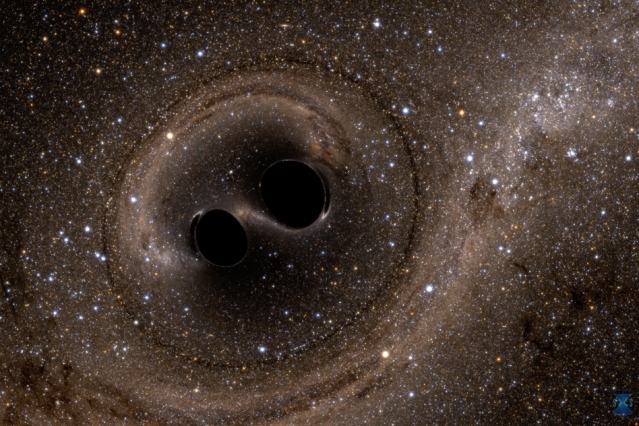
Photo courtesy of Wikimedia Commons
For the last few months the discovery of gravitational waves has been all over the news, but what are gravitational waves and what do they do?
Gravitational waves are distortions in the fabric of space- time caused by violent and energetic processes in the universe. While the way gravitational waves are created is extremely violent, by the time they arrive at Earth they are millions of times smaller and less disruptive than they were at their creation.
The existence of gravitational waves was first hypothesized by Albert Einstein’s General Theory of Relativity, but Einstein wasn’t able to find any proof of the waves in his lifetime. In search of proof of gravitational waves, scientists created a large-scale physics experiment and observatory for this project. The project, called The Laser Interferometer Gravitational Wave Observatory (LIGO), is a result of collaboration between many colleges and universities. LIGO is essentially a large-scale physics experiment and observatory that was designed by physicists at MIT and Caltech to detect gravitational waves. Members of the LIGO group work alongside a worldwide team of scientists, but mainly with a European team known as the Virgo Collaboration.
While many such observatories exist in the world, LIGO is the largest one. It is comprised of two gigantic laser interferometers that are thousands of kilometers apart. LIGO utilizes both the physical properties of light and also space itself to detect and understand the origins of gravitational waves. As gravitational waves ripple over us,
there are tiny changes in the dimensions of whatever it passes through. But the changes in dimensions are so minute (not even comparable to a single atom) that it has been extremely difficult to track them.
For the last 50 years LIGO has constantly been running experiments and going through the trial and error process. It has spent 25 years perfecting a set of instruments that are sensitive enough to identify a distortion in spacetime a thousandth the diameter of one atomic nucleus across a 4 kilometer strip of laser beam and a mirror
When asked about the importance of the gravitational waves experiment Professor Alberto Vecchino, a researcher at LIGO, states, “We have observed the universe through light so far. But we can only see part of what happens in the universe. Gravitational waves carry completely
different information about the phenomena in the universe. So we have opened a new way of listening to a broadcasting channel which will allow us to discover phenomena we have never seen before.”
After fifty years of listening, gravitational waves were detected on September 14, 2015. The gravitational waves, which resulted from a collision that dates back to 1.3 billion years ago and are approximately 50 times more powerful than all the stars in the universe combined, vibrated a pair of antennas in both Washington State and Louisiana. The waves were created through the vibration of two black holes merging, as if they were eating each other.
While the discovery of gravitational waves has yet to bring forth vital information, many scientists believe that gravitational waves are extremely promising in terms of guiding scientists towards new research and possibilities. Szabolcs Marka, a professor from Columbia University and also scientist at LIGO, emphasizes the potential of the waves when she states, “I think this will be one of the major breakthroughs in physics for a long time. Everything else in astronomy is like the eye. Finally, astronomy grew ears. We never had ears before.”
The discoveries that may follow the findings of gravitational waves is infinite! The study of gravitational astronomy is now a feasible reality for researchers. This allows scientists to see the universe from a completely different perspective – through sounds and frequency. When asked about the vitalness of this discovery Neil Turok, physicist and Perimeter Institute Director, stated, “Once we’ve collected data from the pairs of black holes, they will be like lighthouses scattered through the universe. We will be able to measure the rate the universe is expanding, how much dark energy there is in the universe to extraordinary precision, and more!”







